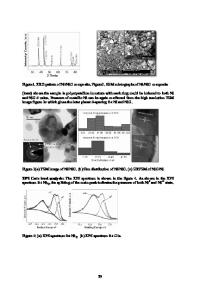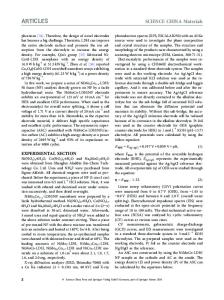Metal oxides nanostructure-based electrode materials for supercapacitor application
- PDF / 966,550 Bytes
- 18 Pages / 547.087 x 737.008 pts Page_size
- 12 Downloads / 458 Views
REVIEW
Metal oxides nanostructure-based electrode materials for supercapacitor application Mahendra Singh Yadav
Received: 8 May 2020 / Accepted: 24 November 2020 # Springer Nature B.V. 2020
Abstract Recently, electrochemical supercapacitor has drawn more attention because of its superior electrochemical properties including larger life cycle, higher specific capacitance, and larger specific power. The supercapacitor is also able to fill the energy and power gap between battery and traditional capacitor. The supercapacitor has been considered suitable as an energy storage device for next-generation higher power applications. The ultracapacitor design using nanostructure-based electrode materials has provided better electrochemical properties. This review article gives a brief overview about the latest research trends on metal oxides nanostructure-based electrode materials for ultracapacitors and, in addition, highlights the nanomaterial effect on the electrode properties of
Highlights • Development of alternative energy sources such as renewable energy. • Energy storage devices have received more attention and attained a crucial role in storage of the maximum energy. • Transition metal oxides are used as electrode materials for pseudocapacitors. • Nanomaterials are promising candidates for energy storage device application due to their excellent physical and chemical properties. • Fabrication of supercapacitor electrodes. M. S. Yadav (*) Department of Electronics and Communication Engineering, Jaypee University of Engineering and Technology, Guna, Madhya Pradesh 473226, India e-mail: [email protected]
ultracapacitors, which gives guidance in developing high-performance next-generation ultracapacitors. Keywords Nanoparticles . Nanocomposite . Metal oxides . Nanostructure . Electrode materials . Supercapacitor
Introduction Historically, the first supercapacitor or ultracapacitor was developed by General Electric in 1957. In this case, energy has been stored by a double-layer mechanism in the pores of carbon resulting in a very high specific capacitance (US patent 2800616 n.d.). As another milestone in its development, in 1966, a supercapacitor was invented by the Standard Oil Company, Cleveland (SOHIO), in which energy has been stored at a double-layer interface (US patent 3288641 n.d.). In this supercapacitor, a nonaqueous electrolyte has been used. Followed by demonstration of pseudocapacitors and development of materials for supercapacitor electrodes and electrolyte during the last 3 decades, the performance of supercapacitors has been improved to the extent that it has been projected as an important element in energy storage devices and energy delivery system (US patent 2800616 n.d.; US patent 3288641 n.d.). The present-day world is encountering crucial global problems such as sharp increases in the price of oil, natural gas, uranium, and coal, insufficient energy, availability of potable water, declining hydrocarbons and non-renewable sources, and global warming. To
367
Page 2 of 18
meet the challen
Data Loading...











